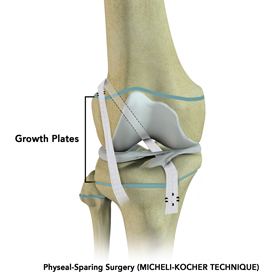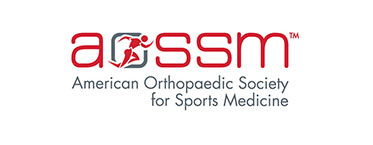
What is Physeal Sparing Surgery?
Surgery may be necessary to reconstruct an irreparable anterior cruciate ligament (torn ACL). In adults, reconstruction of the ACL involves passing a soft tissue graft through tunnels drilled into the shinbone (tibia) and thighbone (femur). In a child or adolescent, such tunnels may damage the physes or growth plates (areas at the ends of long bones where growth is still occurring). A physeal sparing technique may be recommended where the physes in the tibia and femur are left undisturbed, avoiding complications such as growth disturbance or angular deformity.
The technique described by Micheli-Kocher is a type of physeal sparing approach that harvests and uses a part of the iliotibial band (band of tissue that runs along the outside of your thigh) to reconstruct the ACL. It is a combined intra-articular and extra-articular reconstruction technique which is nonanatomic as the relocated IT band strip does not pass through the bone at the original ACL attachments.
What are the Indications for Physeal Sparing Surgery?
An ACL reconstruction is recommended for active children who are involved in sports or recreational activities. Severe knee pain and inability to continue activities are the primary indications for ACL reconstruction. Knee instability due to an ACL tear can lead to meniscal and cartilage injuries and early onset of arthritis.
The other indications include:
- Failure to improve or comply with non-operative treatment
- A recurrent feeling of knee instability with daily activities
- Associated meniscal tears and/or severe injuries to other knee ligaments
- Generalized laxity of the ligaments
Physeal sparing surgery is preferred for children younger than 10-12 years of age with significant skeletal immaturity.
What are the Benefits of Physeal Sparing Surgery Described by Micheli-Kocher)?
The benefits of the procedure include:
- No injury to the physes, minimizing the risk of growth disturbance, leg length abnormalities and angular deformities
- Cartilage damage is minimized due to improved stability
- Low revision rate and excellent functional outcome.
How Do You Prepare for Physeal Sparing Surgery?
Your doctor may recommend using a brace to allow some healing of the ligaments before surgery is performed. You may need to undergo some physical therapy to improve range of motion. If the knee is stiff at the time of surgery, restoring range of motion may be difficult afterward. You may be given specific instructions on dos and don’ts before and on the day of your surgery. Instructions may include details on food intake, medication, etc. Arrange for someone to drive you home after surgery.
Micheli-Kocher Technique for Physeal Sparing ACL Reconstruction
Your surgeon harvests and uses a strip of the iliotibial band as a graft for ACL reconstruction.
During the procedure:
- An incision is made to access the iliotibial band and other incisions are made over the knee joint.
- A strip of IT band is isolated by cutting a part of the IT band in the central portion. The lower end of the strip remains attached to the tibia.
- The upper end of the strip is brought around behind the lower end of the femur and enters the knee through the notch or space between the femoral condyles.
- The IT band strip is secured to the periosteum of the outer or lateral femoral condyle with sutures (extra-articular reconstruction)
- It then passes out to the front of the knee where it is sutured to the periosteum of the upper tibia near the inside (intra-articular reconstruction)
Micheli-Kocher physeal sparing surgery is thus performed without drilling any tunnels through the bone.
Drawbacks of Physeal Sparing Surgery Described by Micheli-Kocher
The drawbacks of this technique include:
- Nonanatomic reconstruction of the ACL, does not provide isometry
- Technically demanding
What Precautions Should be Taken as You Recover from the Procedure?
Rehabilitation is important to help you return to your regular activities and sports. You will work with a therapist to help you safely achieve these goals. Therapy is initiated within 1-2 weeks following surgery and will focus on improving range of motion and strength. You will have to adhere to certain activity limitations initially. As you progress with therapy the focus shifts towards improving balance and neuromuscular control. At 3 months, you should be able to jog, and sports specific training can safely be introduced after 6 months. Special training to optimize movement patterns during athletics can help prevent ACL injuries.




